Macroeconomics Homework Assignment 8 - University Economics
VerifiedAdded on 2022/08/08
|10
|1753
|24
Homework Assignment
AI Summary
This macroeconomics homework assignment delves into various key concepts including interest rates, money supply, and inflation within an open economy framework. The assignment begins by analyzing the equilibrium interest rate in an international goods market, calculating levels of savings, investment, and net exports for both the US and China. It then examines the impact of changes in inflationary expectations on real interest rates and economic output, supported by the Fisher equation. The assignment also explores the effects of an economic slowdown on money supply and demand, and discusses the role of monetary policy in maintaining market equilibrium, including the application of contractionary monetary policy. Furthermore, the assignment covers the concept of money velocity and its implications for economic contraction, illustrating it with the example of the 2008 economic crisis. Finally, the assignment touches upon liquidity traps and the measures taken by the Fed in response to economic challenges. The solution includes graphical representations and calculations to support the analysis, providing a comprehensive understanding of macroeconomic principles.
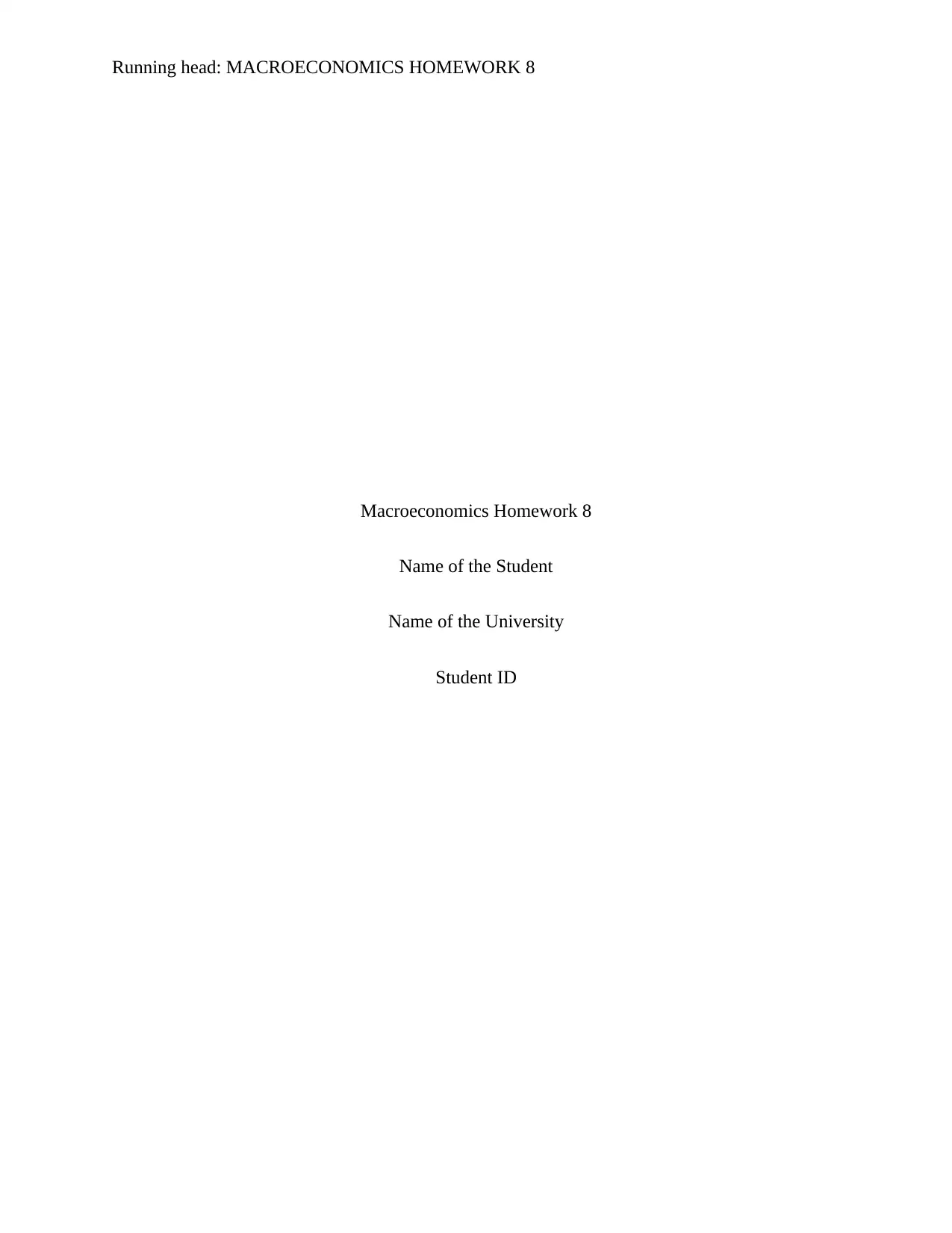
Running head: MACROECONOMICS HOMEWORK 8
Macroeconomics Homework 8
Name of the Student
Name of the University
Student ID
Macroeconomics Homework 8
Name of the Student
Name of the University
Student ID
Paraphrase This Document
Need a fresh take? Get an instant paraphrase of this document with our AI Paraphraser
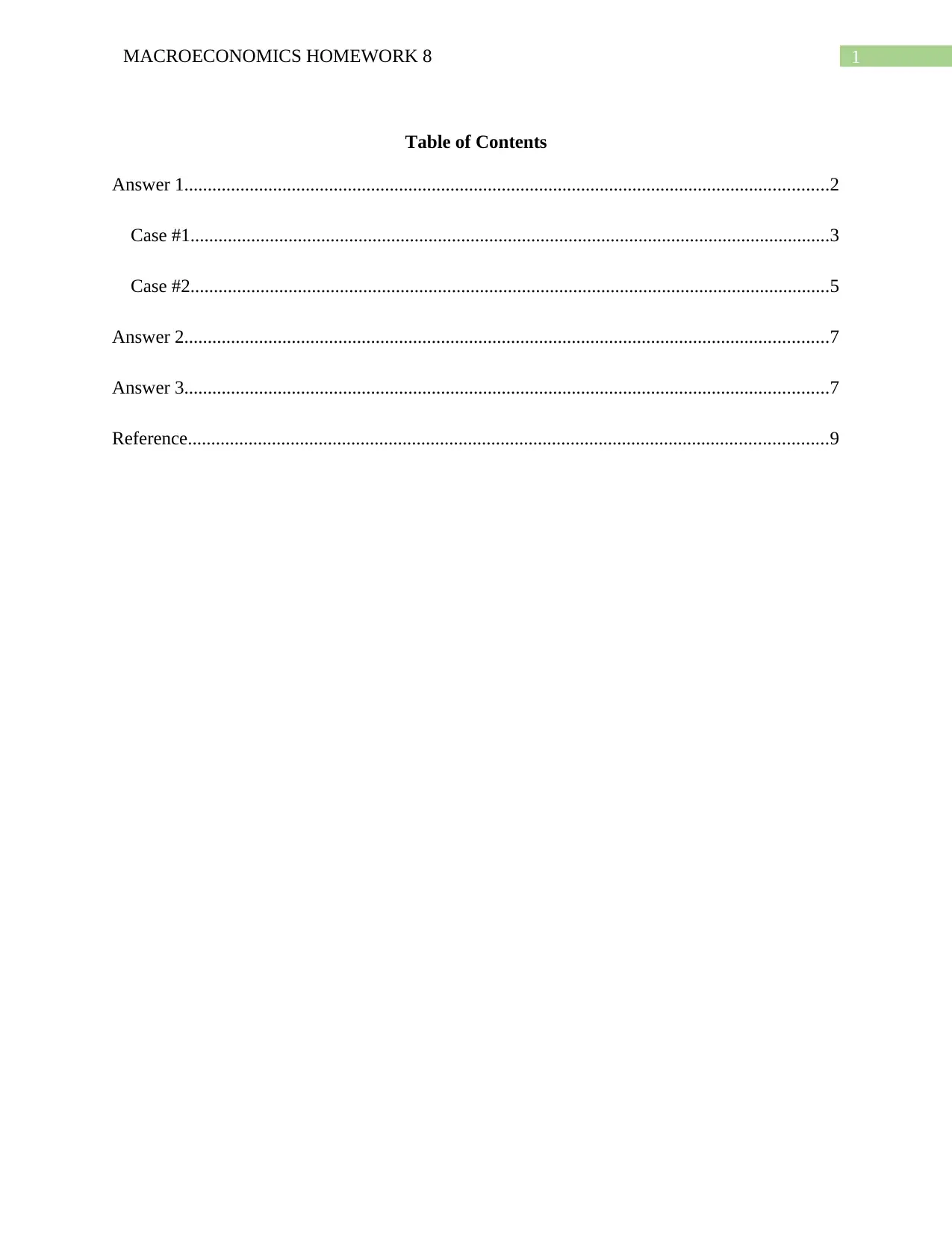
1MACROECONOMICS HOMEWORK 8
Table of Contents
Answer 1..........................................................................................................................................2
Case #1.........................................................................................................................................3
Case #2.........................................................................................................................................5
Answer 2..........................................................................................................................................7
Answer 3..........................................................................................................................................7
Reference.........................................................................................................................................9
Table of Contents
Answer 1..........................................................................................................................................2
Case #1.........................................................................................................................................3
Case #2.........................................................................................................................................5
Answer 2..........................................................................................................................................7
Answer 3..........................................................................................................................................7
Reference.........................................................................................................................................9
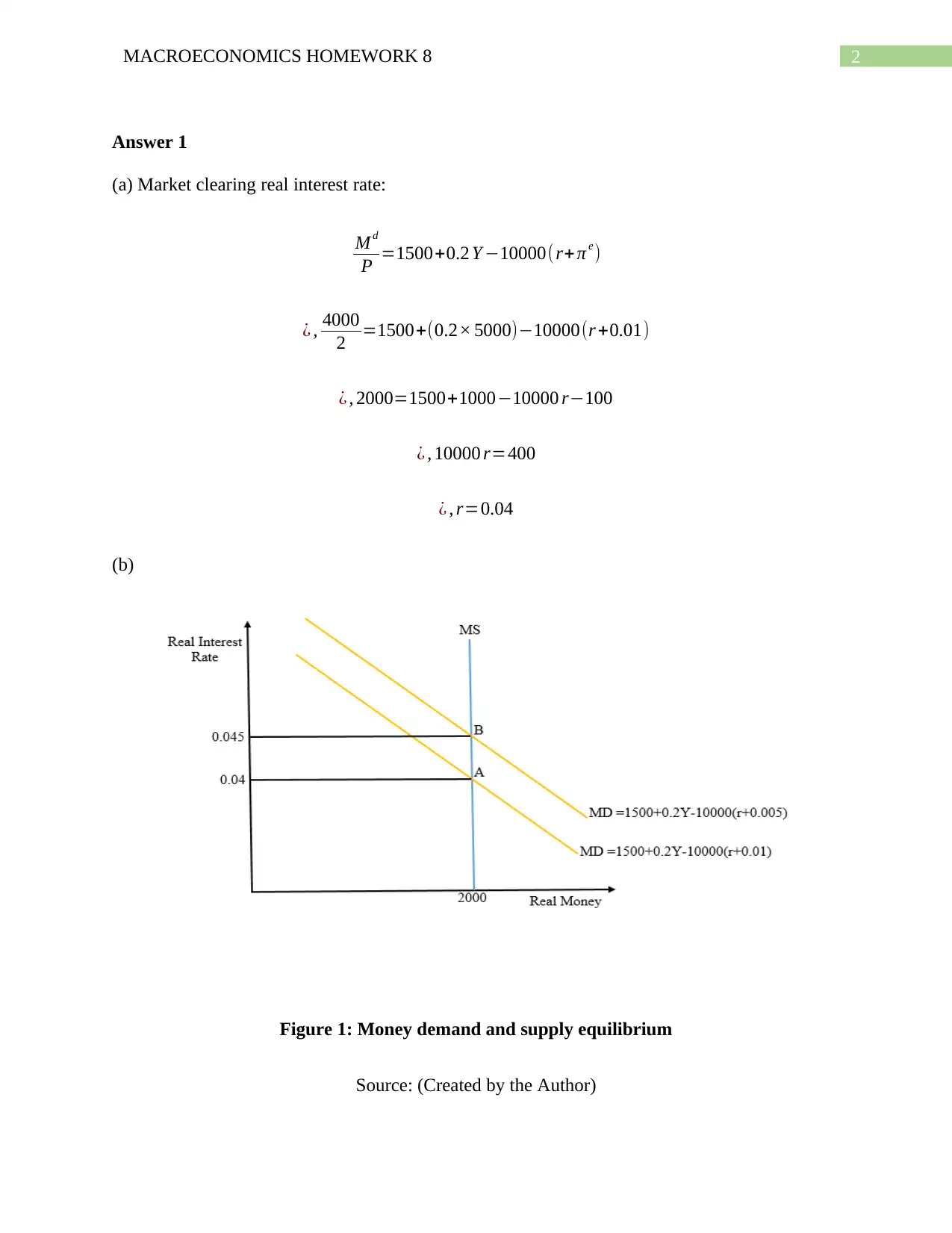
2MACROECONOMICS HOMEWORK 8
Answer 1
(a) Market clearing real interest rate:
M d
P =1500+0.2 Y −10000(r+π e)
¿ , 4000
2 =1500+(0.2× 5000)−10000(r +0.01)
¿ , 2000=1500+1000−10000 r−100
¿ , 10000 r=400
¿ , r=0.04
(b)
Figure 1: Money demand and supply equilibrium
Source: (Created by the Author)
Answer 1
(a) Market clearing real interest rate:
M d
P =1500+0.2 Y −10000(r+π e)
¿ , 4000
2 =1500+(0.2× 5000)−10000(r +0.01)
¿ , 2000=1500+1000−10000 r−100
¿ , 10000 r=400
¿ , r=0.04
(b)
Figure 1: Money demand and supply equilibrium
Source: (Created by the Author)
⊘ This is a preview!⊘
Do you want full access?
Subscribe today to unlock all pages.

Trusted by 1+ million students worldwide
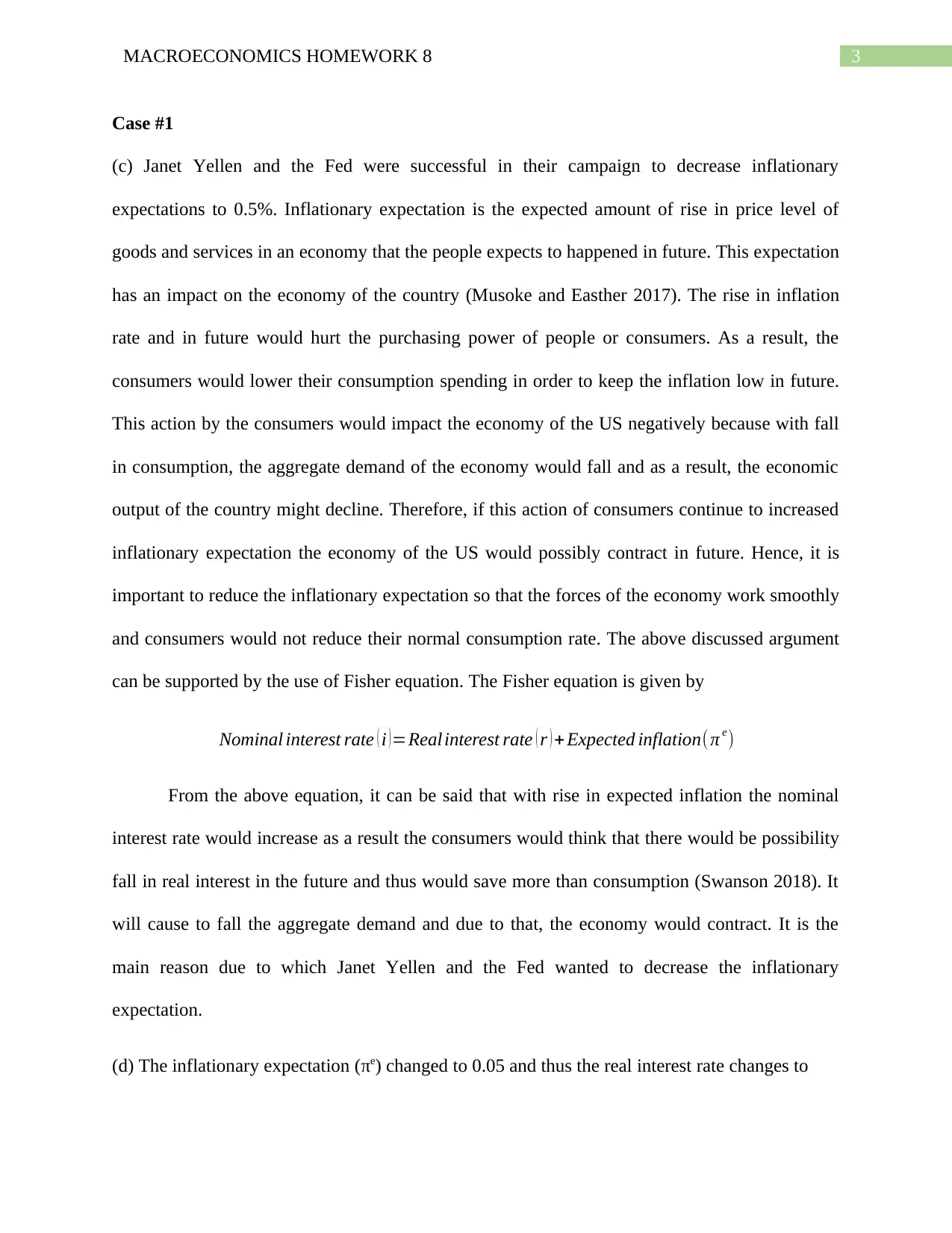
3MACROECONOMICS HOMEWORK 8
Case #1
(c) Janet Yellen and the Fed were successful in their campaign to decrease inflationary
expectations to 0.5%. Inflationary expectation is the expected amount of rise in price level of
goods and services in an economy that the people expects to happened in future. This expectation
has an impact on the economy of the country (Musoke and Easther 2017). The rise in inflation
rate and in future would hurt the purchasing power of people or consumers. As a result, the
consumers would lower their consumption spending in order to keep the inflation low in future.
This action by the consumers would impact the economy of the US negatively because with fall
in consumption, the aggregate demand of the economy would fall and as a result, the economic
output of the country might decline. Therefore, if this action of consumers continue to increased
inflationary expectation the economy of the US would possibly contract in future. Hence, it is
important to reduce the inflationary expectation so that the forces of the economy work smoothly
and consumers would not reduce their normal consumption rate. The above discussed argument
can be supported by the use of Fisher equation. The Fisher equation is given by
Nominal interest rate ( i )=Real interest rate ( r ) + Expected inflation( π e)
From the above equation, it can be said that with rise in expected inflation the nominal
interest rate would increase as a result the consumers would think that there would be possibility
fall in real interest in the future and thus would save more than consumption (Swanson 2018). It
will cause to fall the aggregate demand and due to that, the economy would contract. It is the
main reason due to which Janet Yellen and the Fed wanted to decrease the inflationary
expectation.
(d) The inflationary expectation (πe) changed to 0.05 and thus the real interest rate changes to
Case #1
(c) Janet Yellen and the Fed were successful in their campaign to decrease inflationary
expectations to 0.5%. Inflationary expectation is the expected amount of rise in price level of
goods and services in an economy that the people expects to happened in future. This expectation
has an impact on the economy of the country (Musoke and Easther 2017). The rise in inflation
rate and in future would hurt the purchasing power of people or consumers. As a result, the
consumers would lower their consumption spending in order to keep the inflation low in future.
This action by the consumers would impact the economy of the US negatively because with fall
in consumption, the aggregate demand of the economy would fall and as a result, the economic
output of the country might decline. Therefore, if this action of consumers continue to increased
inflationary expectation the economy of the US would possibly contract in future. Hence, it is
important to reduce the inflationary expectation so that the forces of the economy work smoothly
and consumers would not reduce their normal consumption rate. The above discussed argument
can be supported by the use of Fisher equation. The Fisher equation is given by
Nominal interest rate ( i )=Real interest rate ( r ) + Expected inflation( π e)
From the above equation, it can be said that with rise in expected inflation the nominal
interest rate would increase as a result the consumers would think that there would be possibility
fall in real interest in the future and thus would save more than consumption (Swanson 2018). It
will cause to fall the aggregate demand and due to that, the economy would contract. It is the
main reason due to which Janet Yellen and the Fed wanted to decrease the inflationary
expectation.
(d) The inflationary expectation (πe) changed to 0.05 and thus the real interest rate changes to
Paraphrase This Document
Need a fresh take? Get an instant paraphrase of this document with our AI Paraphraser
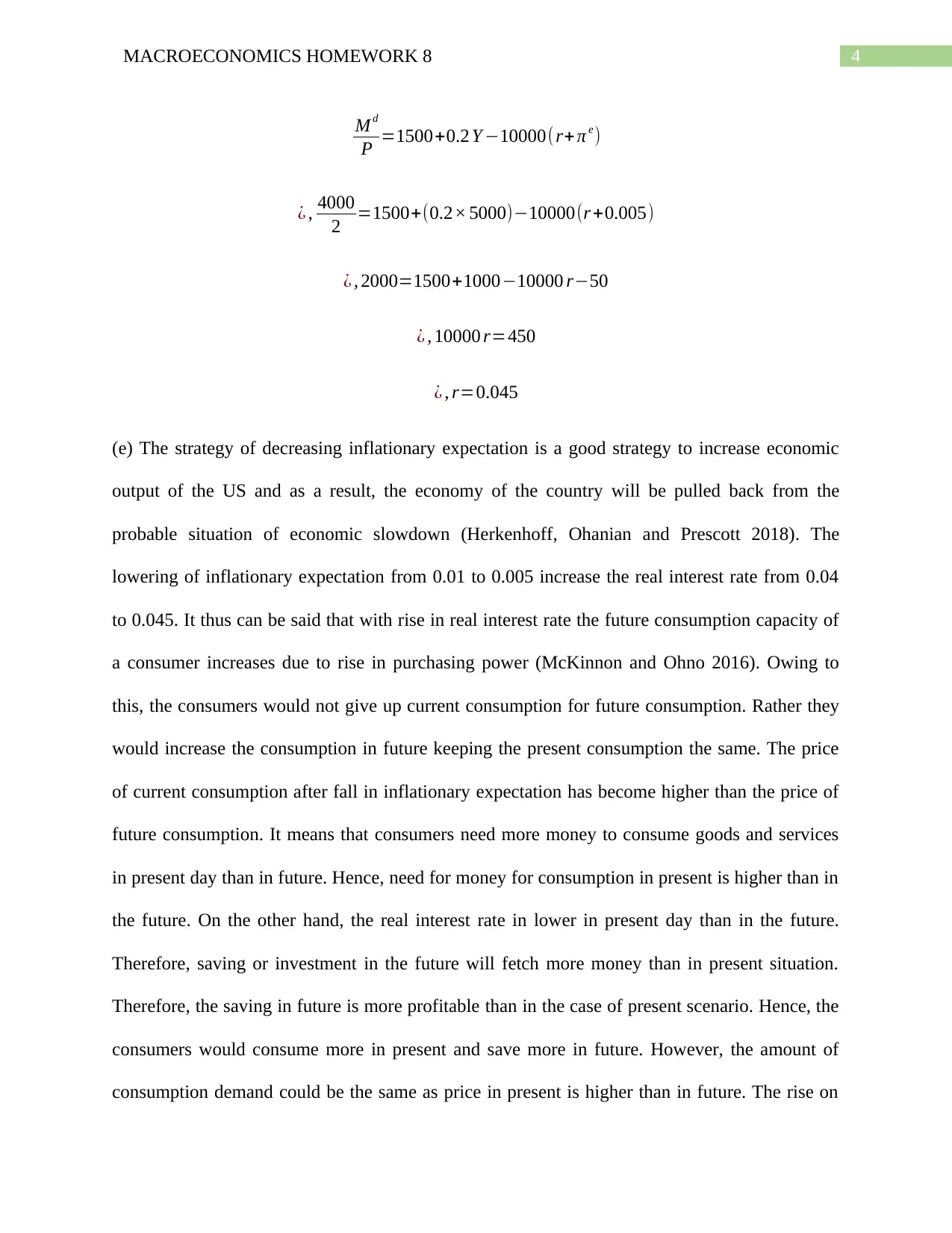
4MACROECONOMICS HOMEWORK 8
M d
P =1500+0.2 Y −10000(r+π e)
¿ , 4000
2 =1500+(0.2× 5000)−10000(r +0.005)
¿ , 2000=1500+1000−10000 r−50
¿ , 10000 r=450
¿ , r=0.045
(e) The strategy of decreasing inflationary expectation is a good strategy to increase economic
output of the US and as a result, the economy of the country will be pulled back from the
probable situation of economic slowdown (Herkenhoff, Ohanian and Prescott 2018). The
lowering of inflationary expectation from 0.01 to 0.005 increase the real interest rate from 0.04
to 0.045. It thus can be said that with rise in real interest rate the future consumption capacity of
a consumer increases due to rise in purchasing power (McKinnon and Ohno 2016). Owing to
this, the consumers would not give up current consumption for future consumption. Rather they
would increase the consumption in future keeping the present consumption the same. The price
of current consumption after fall in inflationary expectation has become higher than the price of
future consumption. It means that consumers need more money to consume goods and services
in present day than in future. Hence, need for money for consumption in present is higher than in
the future. On the other hand, the real interest rate in lower in present day than in the future.
Therefore, saving or investment in the future will fetch more money than in present situation.
Therefore, the saving in future is more profitable than in the case of present scenario. Hence, the
consumers would consume more in present and save more in future. However, the amount of
consumption demand could be the same as price in present is higher than in future. The rise on
M d
P =1500+0.2 Y −10000(r+π e)
¿ , 4000
2 =1500+(0.2× 5000)−10000(r +0.005)
¿ , 2000=1500+1000−10000 r−50
¿ , 10000 r=450
¿ , r=0.045
(e) The strategy of decreasing inflationary expectation is a good strategy to increase economic
output of the US and as a result, the economy of the country will be pulled back from the
probable situation of economic slowdown (Herkenhoff, Ohanian and Prescott 2018). The
lowering of inflationary expectation from 0.01 to 0.005 increase the real interest rate from 0.04
to 0.045. It thus can be said that with rise in real interest rate the future consumption capacity of
a consumer increases due to rise in purchasing power (McKinnon and Ohno 2016). Owing to
this, the consumers would not give up current consumption for future consumption. Rather they
would increase the consumption in future keeping the present consumption the same. The price
of current consumption after fall in inflationary expectation has become higher than the price of
future consumption. It means that consumers need more money to consume goods and services
in present day than in future. Hence, need for money for consumption in present is higher than in
the future. On the other hand, the real interest rate in lower in present day than in the future.
Therefore, saving or investment in the future will fetch more money than in present situation.
Therefore, the saving in future is more profitable than in the case of present scenario. Hence, the
consumers would consume more in present and save more in future. However, the amount of
consumption demand could be the same as price in present is higher than in future. The rise on
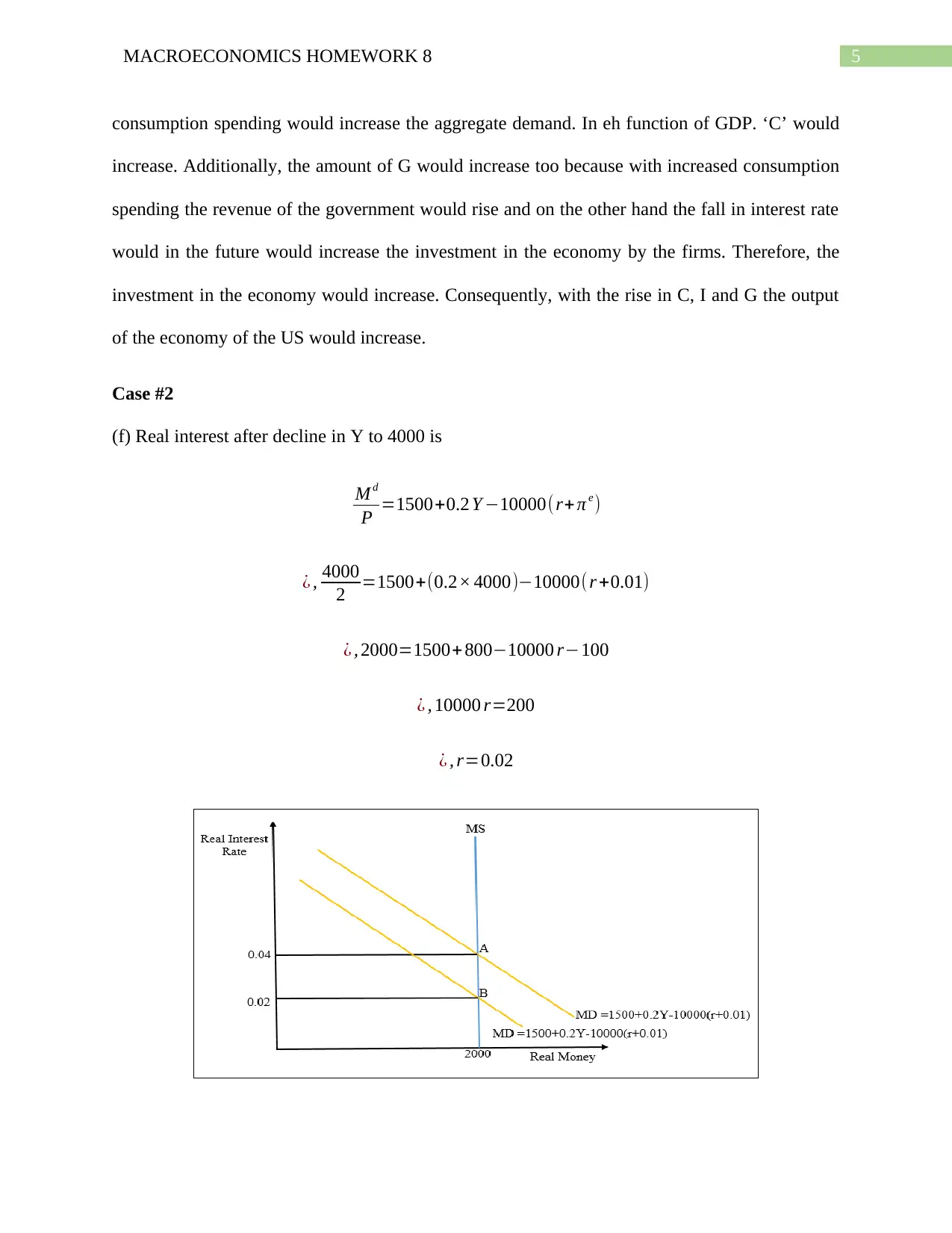
5MACROECONOMICS HOMEWORK 8
consumption spending would increase the aggregate demand. In eh function of GDP. ‘C’ would
increase. Additionally, the amount of G would increase too because with increased consumption
spending the revenue of the government would rise and on the other hand the fall in interest rate
would in the future would increase the investment in the economy by the firms. Therefore, the
investment in the economy would increase. Consequently, with the rise in C, I and G the output
of the economy of the US would increase.
Case #2
(f) Real interest after decline in Y to 4000 is
M d
P =1500+0.2 Y −10000(r+π e)
¿ , 4000
2 =1500+(0.2× 4000)−10000( r +0.01)
¿ , 2000=1500+ 800−10000 r−100
¿ , 10000 r=200
¿ , r=0.02
consumption spending would increase the aggregate demand. In eh function of GDP. ‘C’ would
increase. Additionally, the amount of G would increase too because with increased consumption
spending the revenue of the government would rise and on the other hand the fall in interest rate
would in the future would increase the investment in the economy by the firms. Therefore, the
investment in the economy would increase. Consequently, with the rise in C, I and G the output
of the economy of the US would increase.
Case #2
(f) Real interest after decline in Y to 4000 is
M d
P =1500+0.2 Y −10000(r+π e)
¿ , 4000
2 =1500+(0.2× 4000)−10000( r +0.01)
¿ , 2000=1500+ 800−10000 r−100
¿ , 10000 r=200
¿ , r=0.02
⊘ This is a preview!⊘
Do you want full access?
Subscribe today to unlock all pages.

Trusted by 1+ million students worldwide
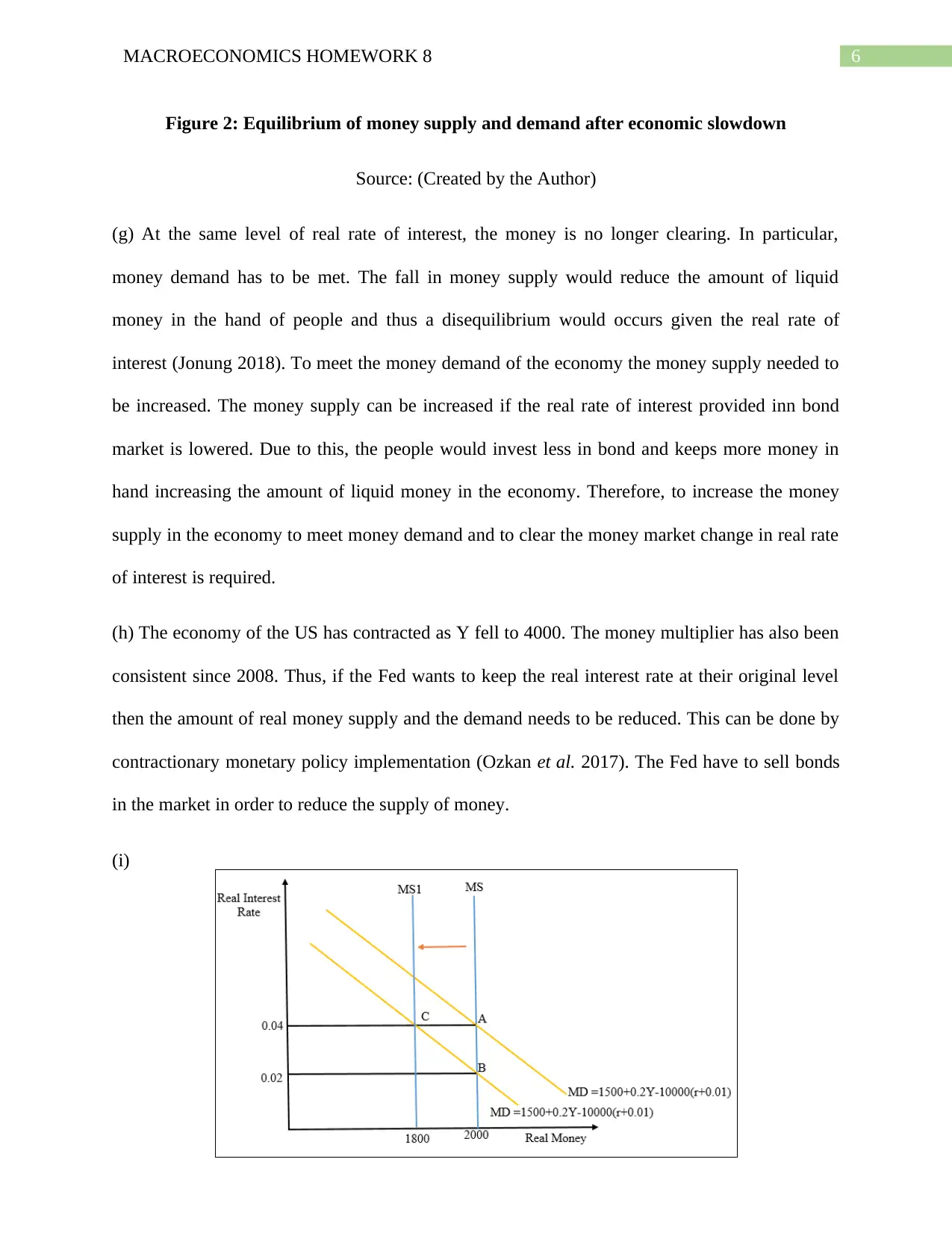
6MACROECONOMICS HOMEWORK 8
Figure 2: Equilibrium of money supply and demand after economic slowdown
Source: (Created by the Author)
(g) At the same level of real rate of interest, the money is no longer clearing. In particular,
money demand has to be met. The fall in money supply would reduce the amount of liquid
money in the hand of people and thus a disequilibrium would occurs given the real rate of
interest (Jonung 2018). To meet the money demand of the economy the money supply needed to
be increased. The money supply can be increased if the real rate of interest provided inn bond
market is lowered. Due to this, the people would invest less in bond and keeps more money in
hand increasing the amount of liquid money in the economy. Therefore, to increase the money
supply in the economy to meet money demand and to clear the money market change in real rate
of interest is required.
(h) The economy of the US has contracted as Y fell to 4000. The money multiplier has also been
consistent since 2008. Thus, if the Fed wants to keep the real interest rate at their original level
then the amount of real money supply and the demand needs to be reduced. This can be done by
contractionary monetary policy implementation (Ozkan et al. 2017). The Fed have to sell bonds
in the market in order to reduce the supply of money.
(i)
Figure 2: Equilibrium of money supply and demand after economic slowdown
Source: (Created by the Author)
(g) At the same level of real rate of interest, the money is no longer clearing. In particular,
money demand has to be met. The fall in money supply would reduce the amount of liquid
money in the hand of people and thus a disequilibrium would occurs given the real rate of
interest (Jonung 2018). To meet the money demand of the economy the money supply needed to
be increased. The money supply can be increased if the real rate of interest provided inn bond
market is lowered. Due to this, the people would invest less in bond and keeps more money in
hand increasing the amount of liquid money in the economy. Therefore, to increase the money
supply in the economy to meet money demand and to clear the money market change in real rate
of interest is required.
(h) The economy of the US has contracted as Y fell to 4000. The money multiplier has also been
consistent since 2008. Thus, if the Fed wants to keep the real interest rate at their original level
then the amount of real money supply and the demand needs to be reduced. This can be done by
contractionary monetary policy implementation (Ozkan et al. 2017). The Fed have to sell bonds
in the market in order to reduce the supply of money.
(i)
Paraphrase This Document
Need a fresh take? Get an instant paraphrase of this document with our AI Paraphraser
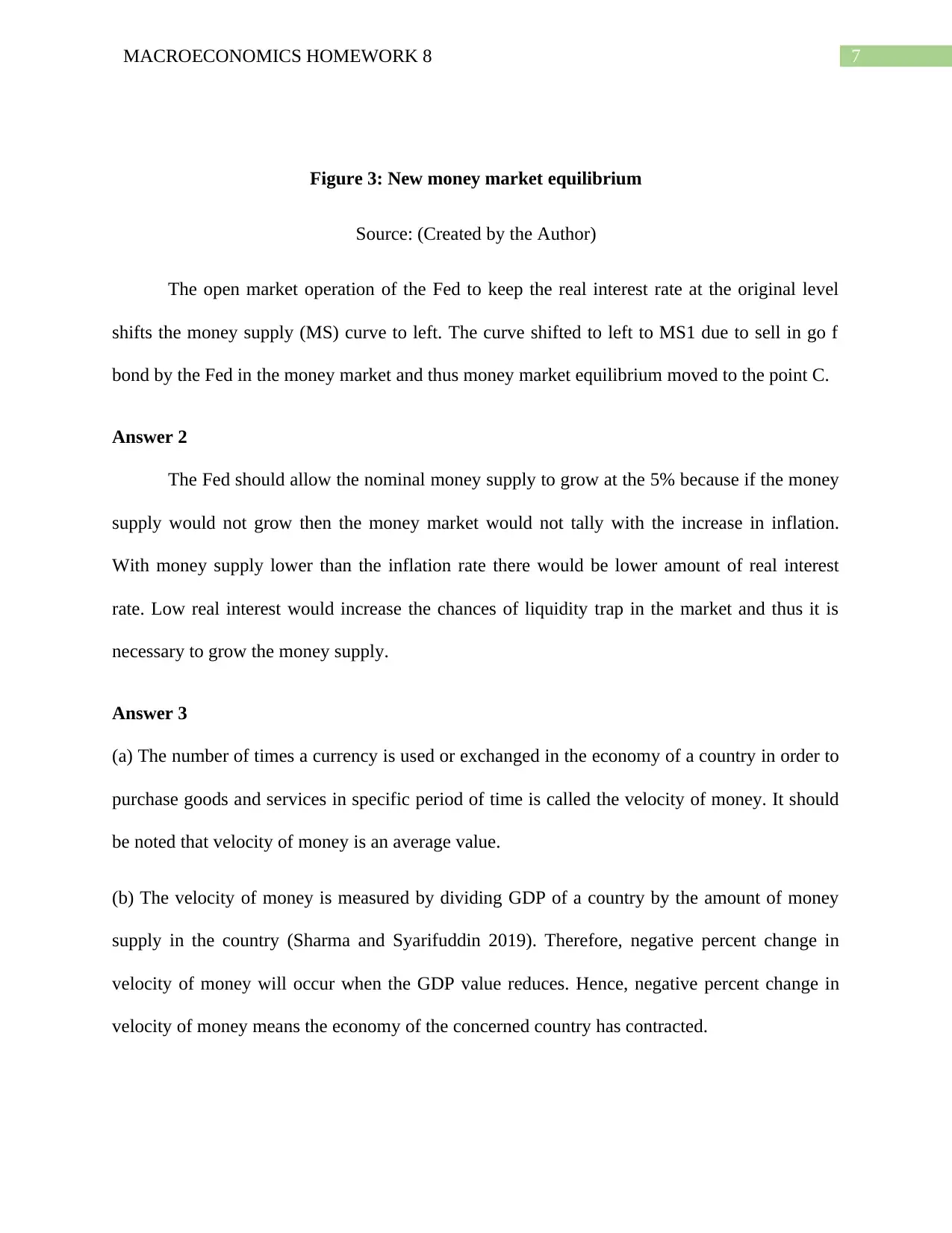
7MACROECONOMICS HOMEWORK 8
Figure 3: New money market equilibrium
Source: (Created by the Author)
The open market operation of the Fed to keep the real interest rate at the original level
shifts the money supply (MS) curve to left. The curve shifted to left to MS1 due to sell in go f
bond by the Fed in the money market and thus money market equilibrium moved to the point C.
Answer 2
The Fed should allow the nominal money supply to grow at the 5% because if the money
supply would not grow then the money market would not tally with the increase in inflation.
With money supply lower than the inflation rate there would be lower amount of real interest
rate. Low real interest would increase the chances of liquidity trap in the market and thus it is
necessary to grow the money supply.
Answer 3
(a) The number of times a currency is used or exchanged in the economy of a country in order to
purchase goods and services in specific period of time is called the velocity of money. It should
be noted that velocity of money is an average value.
(b) The velocity of money is measured by dividing GDP of a country by the amount of money
supply in the country (Sharma and Syarifuddin 2019). Therefore, negative percent change in
velocity of money will occur when the GDP value reduces. Hence, negative percent change in
velocity of money means the economy of the concerned country has contracted.
Figure 3: New money market equilibrium
Source: (Created by the Author)
The open market operation of the Fed to keep the real interest rate at the original level
shifts the money supply (MS) curve to left. The curve shifted to left to MS1 due to sell in go f
bond by the Fed in the money market and thus money market equilibrium moved to the point C.
Answer 2
The Fed should allow the nominal money supply to grow at the 5% because if the money
supply would not grow then the money market would not tally with the increase in inflation.
With money supply lower than the inflation rate there would be lower amount of real interest
rate. Low real interest would increase the chances of liquidity trap in the market and thus it is
necessary to grow the money supply.
Answer 3
(a) The number of times a currency is used or exchanged in the economy of a country in order to
purchase goods and services in specific period of time is called the velocity of money. It should
be noted that velocity of money is an average value.
(b) The velocity of money is measured by dividing GDP of a country by the amount of money
supply in the country (Sharma and Syarifuddin 2019). Therefore, negative percent change in
velocity of money will occur when the GDP value reduces. Hence, negative percent change in
velocity of money means the economy of the concerned country has contracted.
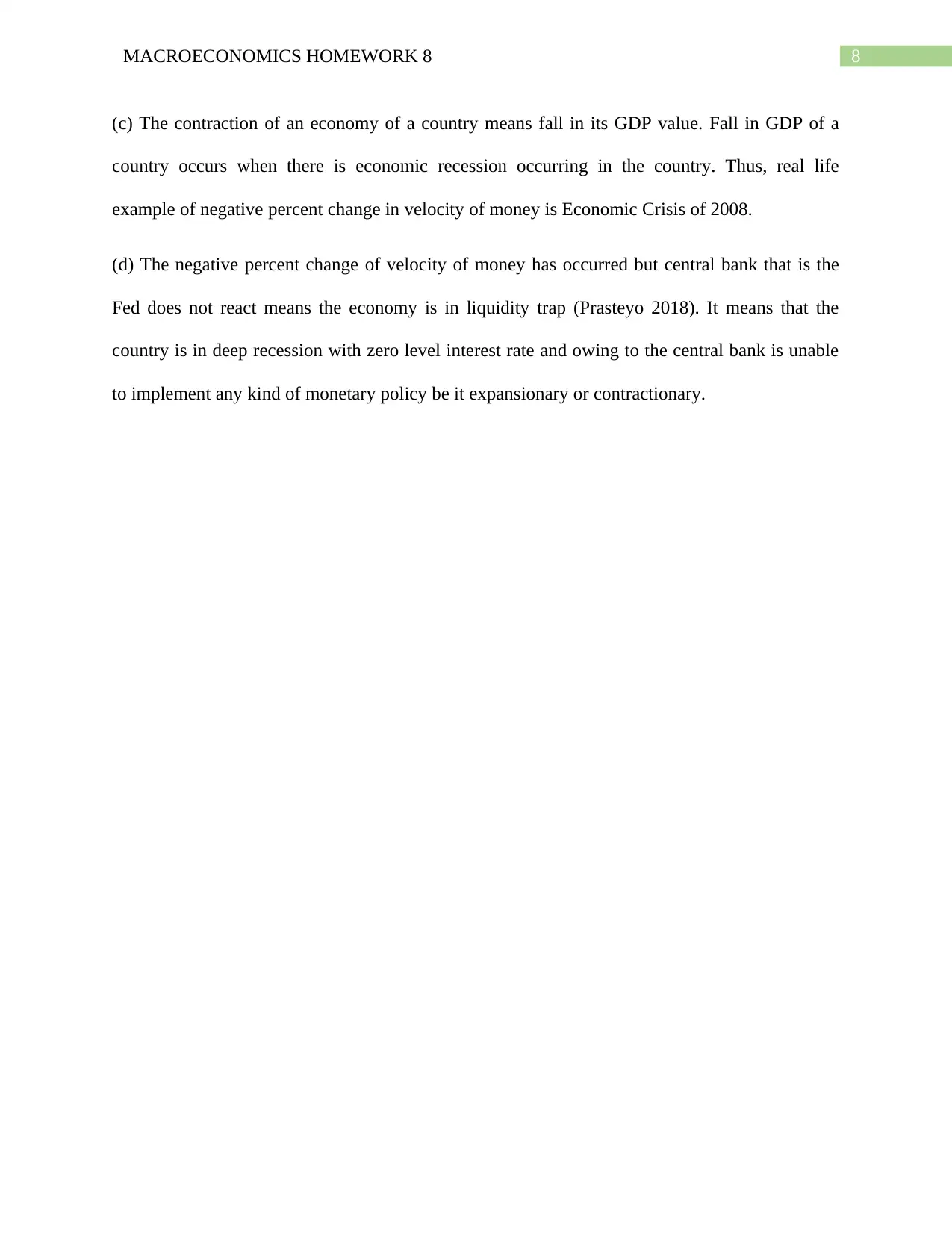
8MACROECONOMICS HOMEWORK 8
(c) The contraction of an economy of a country means fall in its GDP value. Fall in GDP of a
country occurs when there is economic recession occurring in the country. Thus, real life
example of negative percent change in velocity of money is Economic Crisis of 2008.
(d) The negative percent change of velocity of money has occurred but central bank that is the
Fed does not react means the economy is in liquidity trap (Prasteyo 2018). It means that the
country is in deep recession with zero level interest rate and owing to the central bank is unable
to implement any kind of monetary policy be it expansionary or contractionary.
(c) The contraction of an economy of a country means fall in its GDP value. Fall in GDP of a
country occurs when there is economic recession occurring in the country. Thus, real life
example of negative percent change in velocity of money is Economic Crisis of 2008.
(d) The negative percent change of velocity of money has occurred but central bank that is the
Fed does not react means the economy is in liquidity trap (Prasteyo 2018). It means that the
country is in deep recession with zero level interest rate and owing to the central bank is unable
to implement any kind of monetary policy be it expansionary or contractionary.
⊘ This is a preview!⊘
Do you want full access?
Subscribe today to unlock all pages.

Trusted by 1+ million students worldwide
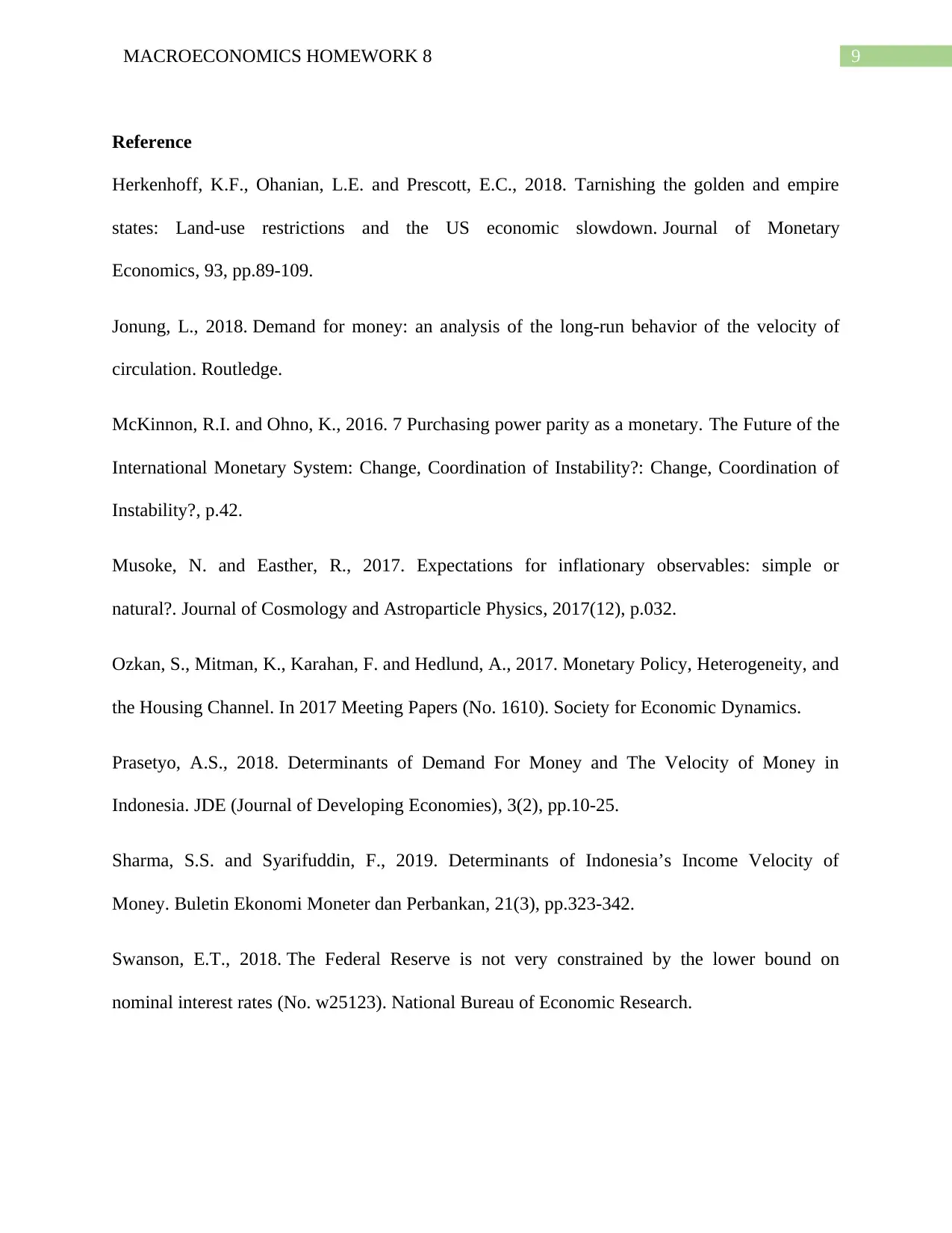
9MACROECONOMICS HOMEWORK 8
Reference
Herkenhoff, K.F., Ohanian, L.E. and Prescott, E.C., 2018. Tarnishing the golden and empire
states: Land-use restrictions and the US economic slowdown. Journal of Monetary
Economics, 93, pp.89-109.
Jonung, L., 2018. Demand for money: an analysis of the long-run behavior of the velocity of
circulation. Routledge.
McKinnon, R.I. and Ohno, K., 2016. 7 Purchasing power parity as a monetary. The Future of the
International Monetary System: Change, Coordination of Instability?: Change, Coordination of
Instability?, p.42.
Musoke, N. and Easther, R., 2017. Expectations for inflationary observables: simple or
natural?. Journal of Cosmology and Astroparticle Physics, 2017(12), p.032.
Ozkan, S., Mitman, K., Karahan, F. and Hedlund, A., 2017. Monetary Policy, Heterogeneity, and
the Housing Channel. In 2017 Meeting Papers (No. 1610). Society for Economic Dynamics.
Prasetyo, A.S., 2018. Determinants of Demand For Money and The Velocity of Money in
Indonesia. JDE (Journal of Developing Economies), 3(2), pp.10-25.
Sharma, S.S. and Syarifuddin, F., 2019. Determinants of Indonesia’s Income Velocity of
Money. Buletin Ekonomi Moneter dan Perbankan, 21(3), pp.323-342.
Swanson, E.T., 2018. The Federal Reserve is not very constrained by the lower bound on
nominal interest rates (No. w25123). National Bureau of Economic Research.
Reference
Herkenhoff, K.F., Ohanian, L.E. and Prescott, E.C., 2018. Tarnishing the golden and empire
states: Land-use restrictions and the US economic slowdown. Journal of Monetary
Economics, 93, pp.89-109.
Jonung, L., 2018. Demand for money: an analysis of the long-run behavior of the velocity of
circulation. Routledge.
McKinnon, R.I. and Ohno, K., 2016. 7 Purchasing power parity as a monetary. The Future of the
International Monetary System: Change, Coordination of Instability?: Change, Coordination of
Instability?, p.42.
Musoke, N. and Easther, R., 2017. Expectations for inflationary observables: simple or
natural?. Journal of Cosmology and Astroparticle Physics, 2017(12), p.032.
Ozkan, S., Mitman, K., Karahan, F. and Hedlund, A., 2017. Monetary Policy, Heterogeneity, and
the Housing Channel. In 2017 Meeting Papers (No. 1610). Society for Economic Dynamics.
Prasetyo, A.S., 2018. Determinants of Demand For Money and The Velocity of Money in
Indonesia. JDE (Journal of Developing Economies), 3(2), pp.10-25.
Sharma, S.S. and Syarifuddin, F., 2019. Determinants of Indonesia’s Income Velocity of
Money. Buletin Ekonomi Moneter dan Perbankan, 21(3), pp.323-342.
Swanson, E.T., 2018. The Federal Reserve is not very constrained by the lower bound on
nominal interest rates (No. w25123). National Bureau of Economic Research.
1 out of 10
Related Documents
Your All-in-One AI-Powered Toolkit for Academic Success.
+13062052269
info@desklib.com
Available 24*7 on WhatsApp / Email
![[object Object]](/_next/static/media/star-bottom.7253800d.svg)
Unlock your academic potential
Copyright © 2020–2025 A2Z Services. All Rights Reserved. Developed and managed by ZUCOL.



